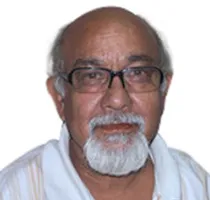-
CENTRES
Progammes & Centres
Location

Possibility of a state government led by Shiv Sena-Nationalist Congress Party-Congress combine coming to power appears to be strong in the state of Maharashtra where there has been political instability since declaration of assembly election results on 24 October.
Success or defeat of the experiment being tried in Maharashtra whose capital incidentally is also the finance capital of the country, Mumbai, and its longevity would enlighten the opposition path paving the way for similar exercises elsewhere, including at the national level.
Maharashtra is currently under President’s rule. Instability as the pre-poll electoral alliance between the ruling BJP-Shiv Sena combine failed to stake a claim to form a government despite the popular mandate for it. Even the Shiv Sena and the NCP, when invited by Governor Bhagat Singh Koshyari to form a government, could not stake a claim for lack of sufficient time to cobble an alliance that could prove majority on the floor of the house.
The two very old alliance partners fell apart on the issue of the chief minister’s seat, leading to imposition of President’s rule in the state. It resulted in the break-up of the almost three decades old alliance. The Shiv Sena and the BJP had ostensibly come together because both had claimed to be working to protect, preserve and further the interest of Hindus and against the domination of the Congress in national politics which according to the two, was appeasing the largest minority group of Muslims.
In these elections, the BJP, Shiv Sena, NCP and Congress had won 105, 56, 54 and 44 seats respectively. But despite the ruling alliance having a clear majority, the two could not agree on the issue of division of power between them as the Shiv Sena supremo Uddhav Thackeray insisted that a pre-poll understanding rather a commitment of sharing the chief ministerial post 50:50 between the two partners be honoured.
However, the BJP refused to accept the demand asserting that no commitment was ever made. Duo of Prime Minister Narendra Modi and Union Home Minister Amit Shah stood firm, refusing to accept the demand, forcing Shiv Sena to explore other avenues to achieve its ambition of being in the driving seat.
The two main opposition parties-the NCP and the Congress- were naturally following the developments keenly, waiting in the wings to exploit the growing differences between their political rivals to their advantage.
NCP supremo Sharad Pawar, who is a seasoned political craftsman having been a participated in the country’s politics for over six decades rising from the ranks to occupy some of the highest possible positions in the government and politics, has become the pivot around whom contours of a significant experiment are being shaped. He is steering the negotiations for evolving an understanding to resolve differences to bring the three on a common minimum agenda that could become the foundation of a government between the three erstwhile arch rivals.
The Congress, country’s oldest party, was initially hesitant with its interim chief Sonia Gandhi facing a mental block to cross the self-imposed ideological Lakshman Rekha that prevented it to join hands with a so-called and so labelled communal party. Talks between the NCP chief and the Congress interim president helped to remove some doubts.
After prolonged deliberations and consultations with senior leaders and state leaders primarily those from Maharashtra, the Congress decided to go ahead with talks on the process of government formation taking enough care to plug in issues that could possibly crop up in future becoming the cause of downfall of a future government between the three. After getting the Sonia Gandhi’s nod, talks on details of sharing of power and framing of a common minimum programme (CMP) began in right earnest with Pawar playing the role of a sheet anchor.
Process is slow and time consuming, The three prospective partners are taking time to hedge their respective political interests and to remove possible traps that could sound the end an experiment in political power sharing between three ideologically divergent political parties promising to become one of the possible models to challenge the domination of the BJP at the national as well as state level.
The Bharatiya Janata Party (BJP) has been in power for close to six years winning two successive Lok Sabha polls turning the national politics into BJP versus the rest but despite its literal decimation, the opposition of all hues and ideological shades has continued to remain divided groping in dark for an attractive enough narrative and vision to ignite people’s mind to meet the challenge to country’s democracy.
All opposition parties without an exception are apparently not ready to accept the political ground realities that times are changing fast with new challenges coming up as society undergoes a transformation with new values being firmed up and aspiration levels rising. The opposition has to accept the days of politics of ideologies are over because citizens are looking for politics of content that provides them peace, prosperity and progress.
On the one hand, the BJP, through its shrewd political narrative of nationalism is diverting the popular attention from existential issues that concern livelihood, security and other day-to-day problems. While on the other, the opposition is still pursuing outdated time wrapped policies and ideologies that have outlived their relevance.
Drawing a list of the BJP’s strengths and weaknesses, and analyzing the reasons for the decimation of the opposition is the need of the hour. A counter-narrative that is more appealing and popularly acceptable needs to be readied for attracting youth of the country so that they wooed away from the toxic Hinduatva narrative that draws its appeal from fake nationalism and hatred against the minorities particularly of the Muslims.
At the same time, the opposition would also have to effectively counter Islamic fundamentalism and obscurantist way of life along with out of sync practices that strengthen the Hindu right.
The views expressed above belong to the author(s). ORF research and analyses now available on Telegram! Click here to access our curated content — blogs, longforms and interviews.

Satish Misra was Senior Fellow at ORF. He has been a journalist for many years. He has a PhD in International Affairs from Humboldt University ...
Read More +